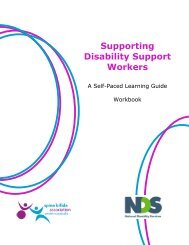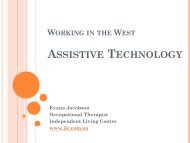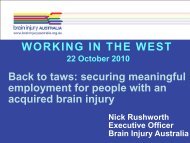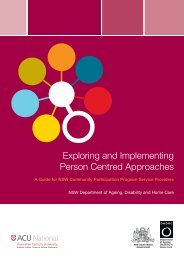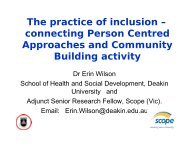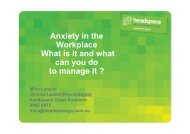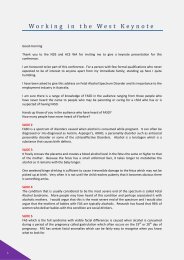Occupational Safety & Health, Workers Compensation ... - IDEASWA
Occupational Safety & Health, Workers Compensation ... - IDEASWA
Occupational Safety & Health, Workers Compensation ... - IDEASWA
- No tags were found...
You also want an ePaper? Increase the reach of your titles
YUMPU automatically turns print PDFs into web optimized ePapers that Google loves.
<strong>Occupational</strong> <strong>Safety</strong> & <strong>Health</strong>,<strong>Workers</strong> <strong>Compensation</strong> &Injury Management ManualProduced for the West Australian Disability Sector in conjunction withNulsen Haven Association, Disability Services Commission, National Disability Services (WA)and AurendaTraining Services
Training ServicesForeword<strong>Occupational</strong> <strong>Safety</strong> and <strong>Health</strong>, <strong>Workers</strong> <strong>Compensation</strong> & Injury Management is a key element in theprovision of services to people with disabilities. Successful and responsive services are intimately relatedto the standard of safety, health and well being of all those involved in providing support and assistance topeople with disabilities. Requirements on organisations are significant in ensuring a safe place of work existsfor those providing the service and those using the service. <strong>Safety</strong> is everybody’s responsibility!This manual has been developed to provide you with all the relevant policies and procedures related to<strong>Occupational</strong> <strong>Safety</strong> and <strong>Health</strong>, <strong>Workers</strong> <strong>Compensation</strong> & Injury Management. Rather than produce acomprehensive manual that duplicates existing information; we have opted on a format that provides you withkey subject areas of <strong>Occupational</strong> <strong>Safety</strong> and <strong>Health</strong> and then links the user to the source of that information.Most of the information we need to access, relating to <strong>Occupational</strong> <strong>Safety</strong> and <strong>Health</strong>, is from governmentdepartments such as Worksafe or Workcover. This manual will provide direct access to this informationelectronically under specific subject headings.We trust that this manual will be a useful resource in ensuring your organisation continues to meet its obligationsin relation to <strong>Occupational</strong> <strong>Safety</strong> and <strong>Health</strong>.I would like to thank NDS WA, Disability Services Commission, Aurenda and Nulsen Haven Training Servicesfor enabling the production of this valuable resource to disability sector organisations in Western Australia.Gordon TrewernChief Executive OfficerNulsen Haven Association (Inc.)<strong>Occupational</strong> <strong>Safety</strong> and <strong>Health</strong>, <strong>Workers</strong> <strong>Compensation</strong> & Injury Management ManualPublished and distributed by Nulsen Haven Association (Inc)First Published: December 2008No part of this publication may be reproduced by any means (includingelectronic, mechanical, microcopying, photocopying, recording or otherwise) withoutprior written permission from the publisher.1 2
<strong>Occupational</strong> <strong>Safety</strong> & <strong>Health</strong> (OSH) System1.0 Introduction<strong>Occupational</strong> safety and health (OSH) is an important part of any business and by protecting staff, clientsand others the business can be successful. <strong>Safety</strong> is seen as everybody’s responsibility and not just that ofmanagement.To assist everybody to take safety seriously, this manual and the safety system has been designed as acatalyst. The implementation and continual monitoring and improvements will ensure safety is just part of whatwe do.1.1 <strong>Occupational</strong> <strong>Safety</strong> & <strong>Health</strong> PolicyThe organisation has developed an OSH policy. This document outlines our commitment and overall intentand approach to safety within the organisation.The policy is a living document and has been designed in consultation with employees and management.1.2 Management CommitmentThe organisation has a commitment to creating a safe and healthy work environment through the developmentand implementation of a safety system.This commitment exists throughout all levels of management within the organisation.1.3 Legislative RequirementsThe organisation strives to achieve legislative compliance in terms of OSH, by ensuring that all legislationrelevant to a specific work-related activity, situation or circumstance is identified and met within your establishedpolicies, procedures, processes and/or general practices.The Regulations detail the requirements or practices that must be adhered to in specific work-related activities,situations and circumstances.The <strong>Occupational</strong> <strong>Safety</strong> and <strong>Health</strong> Act 1984 can be accessed at www.docep.wa.gov.au then click on QUICKLINKS and then click on <strong>Occupational</strong> <strong>Safety</strong> and <strong>Health</strong> Act and Regulations. Staff and management canthen have full access to both of these documents.Other legislation that may affect a specific work-related activity, situation or circumstances in terms of OSHmanagement, along with relevant codes of practice and/or standards, include:• Environmental Protection Act (1986);• <strong>Health</strong> Act (1911);• Industrial Relations Act (1979);• Radiation <strong>Safety</strong> Act (1975);• <strong>Workers</strong> <strong>Compensation</strong> & Injury Management Regulations (1982);• <strong>Workers</strong> <strong>Compensation</strong> & Injury Management Act (1981); and• Criminal Code of Western Australia.1.4 PlanningThe organisation recognises that having a planned and systematic approach to the development, implementationand review of the safety system will assist to reduce injuries and achieve objectives.An annual review will be undertaken to set and/or review objectives, strategies, performance targets andperformance indicators designed to achieving a safe working environment.The organisation sees leadership as a key requirement for success of the safety system.3 4Training Services
1.5 <strong>Occupational</strong> <strong>Safety</strong> & <strong>Health</strong> objectives, targets and performance measuresThe organisation recognises the importance to measure its performance. This can be achieved by :Introducing strategies designed to achieve the objectives;Performance targets; andPerformance indicators.The organisation understands that the OSH knowledge and skill level of managers and supervisors is criticalto the effectiveness of a good safety system and that lack of knowledge could undermine the effectiveness ofthe safety system.1.6 ConsultationThe organisation recognises that the development, implementation, maintenance and improvement of thesafety system are dependent on the cooperation of all employees.Consultation is about participation and open communication between management and employees.Consultative mechanisms encourage and support this.Employees provide major input into the safety system, and without which, it can not be successfully implementedor sustained.The organisation uses various methods of consultation that includes but is not limited to:• staff meetings• safety meetings• notice boards• newsletters• information sheets• messages on pay slipsOSH RepresentativesThe organisation will, where requested by employees, appoint safety representatives in accordance with therelevant sections of the <strong>Occupational</strong> <strong>Safety</strong> and <strong>Health</strong> Act.If no request is made from employees, it is understood that it is the decision of the company to determine ifsafety and health representatives are required. <strong>Safety</strong> is the responsibility of everyone in the workplace and ifresponsibility and consultation is effective then the company may not appoint representatives.If an employee requests that safety and health representatives be elected the company will assist withthe election process. The election is by secret ballot. Once elected the company will inform WorkSafe viathe Election of a <strong>Safety</strong> & <strong>Health</strong> Representative Form. The company will then enroll the person/s into anaccredited 5 day Introductory <strong>Safety</strong> & <strong>Health</strong> Representative course. Once the course has been completed,the company will inform WorkSafe.Refer to Part IV – <strong>Safety</strong> and health representatives and committees of the <strong>Occupational</strong> <strong>Safety</strong> and <strong>Health</strong>Act 1984 www.docep.wa.gov.auOSH CommitteeThe organisation is not required to establish an occupational safety and health committee however if there isa request or an established need, one will be formed. A committee is an effective method of consultation andsharing of information.The organisation requires that all meetings include safety as an agenda item to ensure safety is treated as animportant part of the business at all level on an ongoing basis.Refer to Part IV – <strong>Safety</strong> and health representatives and committees of the <strong>Occupational</strong> <strong>Safety</strong> and <strong>Health</strong>Act 1984 www.docep.wa.gov.au5 6Training Services
1.7 Roles and ResponsibilitiesThe organisations safety management system depends on everyone understanding their respective roles andresponsibilities. Our stakeholders include:• Chief Executive Officer, Managing Director, or similar;• Managers and supervisors• OSH representative(s);• OSH committee members; and• OSH coordinator(s).• Employees;• Contractors;• Clients;• Volunteers; and• Visitors.1.8 Hazard ManagementHazard management is the fundamental function of OSH management.The organisation has established, implemented and maintains policies, procedures and practices to ensurethat:• all hazards in the workplace are identified;• the risks associated with those hazards are assessed;• action is taken to control those risks; and• the identification, assessment and controls are monitored, evaluated, reviewed and improved.We actively encourage our employees, clients, volunteers and contractors to report all hazards. It is onlythrough this that the risk can be identified, assessed and controlled to ensure no one is injured.Hazard identification is everyone’s responsibility, not just the responsibility of the employer, or management,or OSH representative(s), or employees, or contractor(s), or client(s), or visitor(s); but of all these people.Training for employees is ongoing. Hazard forms are used to document the recognised hazards and assist tocollect the relevant data to prevent ongoing injury or damage.There are various methods for identifying hazards. These include;• Consultation with employees in the workplace. Employees possess the knowledge and experience to bestappreciate the hazards that could arise, how they could arise and how to eliminate them;• Inspection of work places;• Review of past hazards, incidents and accidents.The protocol for reducing risk is known as the Hierarchy of Controls which identifies the sequence we shouldfollow in controlling an OSH risk.The Hierarchy of Controls is as follows:Elimination Substitution Engineering Controls Administrative Controls Personal Protective EquipmentElimination is the most effective method of risk control as it is the act of completely removing the risk from theworkplace.Example: The total removal of a particular hazardous substance (chemical) from use within the workplace.Substitution is focused on replacing or introducing new machinery, substances or work practices or processesthat will reduce the level of risk associated with the hazard.Example: Changing a particular chemical used to a less hazardous one.Engineering controls are associated with changing or modifying the workplace or machinery to reduce thelevel of risk.Example: Fitting guards to a piece of machinery, creating a barrier between the person and the hazard.Administrative controls are about re-organising the way work associated with the hazard is being performedand/or providing instruction, training and/or supervision.Example: Defined work breaks to address problems of fatigue.Personal Protective Equipment (PPE) is any item of equipment or clothing that establishes some form ofbarrier between the person and the hazard.Example: Gloves, aprons, safety glasses or goggles.7 8Training Services
1.9 Workplace InspectionsWorkplace inspections are an effective method of identifying hazards.Workplace inspections are the responsibility of the manager. Where there are <strong>Occupational</strong> <strong>Safety</strong> and <strong>Health</strong>representative(s), they will carry out or be involved in the inspections.Workplace inspections are a formal process used to identify and record hazards, actions required to rectifythe hazard and the effectiveness of the actions taken. The responsibility for hazard identification sits witheveryone in the workplace and everyone else in the workplace is responsible for inspecting their workplaceon an ongoing basis.Our workplace is any place, where employees, volunteers work or are likely to be in the course of their work.The organisation recognises that the workplace can take a wide variety of forms, and can include a privateresidence, other organisations properties and vehicles. Inspections of all of these should also be carried outWorkplace inspections are conducted on regular basis, at least monthly. Inspections should be carried out onall new clients homes at assessment stage where ever possible. This may not be possible in the case of crisiscare however all staff must be adequately trained to identify hazards in these instances.1.10 Hazardous SubstancesAll hazardous substances and chemicals used will be stored and used in accordance with manufacturer’sinstructions. Records shall be maintained of hazardous substances used on all sites.Where there is an alternative a non-hazardous substance will be used in place of hazardous substances.Materials <strong>Safety</strong> Data Sheets (MSDS) will be provided for all hazardous substances. Each site will have acentral MSDS Register. Where a new hazardous substance is required it must be approved prior to beingintroduced to the site. All new hazardous substances must have MSDS supplied. MSDS will be displayed inthe work area where the hazardous substances are used or stored.Employees required to use hazardous substances must be appropriately trained.Where staff are required to use hazardous substances in a clients home, only approved hazardous substancescan be used. Clients will be informed as part of the initial assessment process which chemicals must not beused.1.11 Incident, accident reporting and investigationsThe organisations aim is to have no workplace injuries or disease however it recognises that incidents thatresult in injury or harm can occur even with the best of systems.Although an incident-free work place is achievable, incidents do occur from time to time. When they do, weneed to manage them to ensure that not only the impact on the person or persons affected is minimised, butalso that we learn from those events and take appropriate action that those events do not re-occur.Lessons can be learnt from incidents and accidents. The lessons learnt are an opportunity to take the necessarycorrective and preventative actions. This will be achieved through effective reporting and investigating ofworkplace incidents and accidents.Incident accident forms are reviewed by management and discussed at safety meetings, staff meetings andother relevant forums.The organisation investigates incidents and accidents to determine causes and to prevent similar incidents oraccidents occurring. The following can be involved in the investigation process:• the person or persons directly involved or affected by the incident or accident;• the relevant manager or supervisor directly in control of the workplace or work activity associated withthe incident or accident;• the relevant OSH representative(s) or other employee representative(s);• people within the workplace with particular technical knowledge or experience of the workplace orwork activity associated with the incident or accident; and/or• external OSH or other specialists.1.12 Notification of Certain Injuries and DiseasesIt is a legal requirement to ensure certain injuries and diseases are notified to WorkSafe. This can be doneby telephone, email, fax or mail.9 10Training Services
List of Notifiable Injuries and DiseasesInjuriesThe kinds of injuries incurred by an employee to be notified by an employer to the WorkSafe Commissionerare —1.13 Resolution of IssuesConsultative mechanisms involving the organisation and employees will be used to ensure the efficient andcooperative resolution of all issues, including occupational safety and health.(a) a fracture of the skull, spine or pelvis;(b) a fracture of any bone —(i) in the arm, other than in the wrists or hand;(ii) in the leg, other than a bone in the ankle or foot;(c) an amputation of an arm, a hand, finger, finger joint, leg, foot, toe or toe joint;(d) the loss of sight in an eye;(e) any injury other than an injury of a kind referred to in paragraphs (a) to (d) which, in the opinion of amedical practitioner, is likely to prevent the employee from being able to work within 10 days of theday on which the injury occurred.DiseasesThe type of diseases affecting an employee to be notified by an employer to the WorkSafe Commissioner isset out in column 1 of the Table inclusive of the course of the kind of work set out opposite that disease incolumn 2 of the Table.Disease1. Infectious diseases:TuberculosisViral hepatitisLegionnaires’ diseaseHIV2. <strong>Occupational</strong> zoonoses:Q feverAnthraxLeptospirosesBrucellosisWorkWork involving exposure to human blood products,body secretions, excretions or other material whichmay be a source of infection.Work involving the handling of or contact withanimals, animal hides, skins, wool, hair, carcassesor animal waste products.Refer to Part 2 – General, Division 1 – 2.4 <strong>Occupational</strong> <strong>Safety</strong> and <strong>Health</strong> Regulations 199611 12Training Services
1.14 Emergency and EvacuationThe organisation will ensure that evacuation procedures are established reviewed and followed. Wherepracticable evacuation procedures will be clearly and prominently displayed at the workplace. Wherepracticable, a diagram showing the location of exits and the position of the diagram in relation to the exits isclearly and prominently displayed. Training will be provided for all staff and volunteers and where practicable,the evacuation procedure will be practiced regularly.Evidence and records of drills will be maintained and discussed at safety/staff meetings.The organisation recognises various forms of emergencies such as armed hold up, bomb threat, fire etc.Procedures for relevant emergencies have been developed.1.15 TrainingThe effective implementation and maintenance of our occupational safety and health system is dependent onthe competency of our people. Training is one important means of ensuring that the appropriate competenciesto achieve occupational safety and health objectives are met.Planning training is an important part of the process. A training needs analysis and training plan has beenestablished to achieve this.An OSH induction forms a significant part of our OSH training and our consultative mechanisms.All employees, volunteers and where applicable our contractors are included in the induction process.1.16 Preventive MaintenanceThe organisation is committed to ensuring equipment and machinery is well maintained. A maintenanceregister forms part of the process. Maintenance is as per manufacturers specifications unless this is deemedas inadequate.1.17 Record Keeping and VerificationRecord keeping and reporting is the key to any effective OSH management system. The data collectedallows us to track and report our performance. It also provides the raw material for decision-making on themaintenance and improvement of our systems. The records assist to determine the extent to which we cansuccessfully measure and evaluate our OSH management system.Records kept may include:• hazards forms;• incidents, accident forms;• the results of incident, accident investigations;• corrective and preventative action implemented within the workplace;• OSH training records;• safety and health information about equipment/machinery within the workplace;• maintenance register;• all safety and health related policies, procedure, processes and practices;• results of internal and external OSH management system audits/assessments and management reviews;• meeting minutes; and• Chemical and M.S.D.S. RegisterMeasurement, monitoring and evaluationMeasurement and evaluation represent our system’s control function or feedback mechanisms. Measurementand evaluation activities ensure that the performance of our system is in line with our OSH policy, and that weare achieving our specific objectives.By monitoring and measuring the performance indicators of each objective contained within our plan, andevaluating those against the corresponding performance targets, we can determine whether or not ourobjectives are being or have been achieved.13 14Training Services
Audits and assessments are another way to measure and evaluate our system. Internal and external auditsor assessments may be carried out on a periodic basis. The results of such an audit or assessment willconfirm whether the system possesses all the necessary components, and whether they have been effectivelyimplemented.Continuous ImprovementContinuous improvement of our OSH system is achieved by reviewing the system based on the result of yourmeasurement and evaluation processes, and making changes to the system according to those results.Our continuous improvement is achieved when:• we identify areas of opportunity for improvement of our OSH management system which leads to improvedOSH performance;• we determine the root cause of non-conformance or deficiencies;• we develop and implement plans of corrective and preventative action to address root causes;• we verify the effectiveness of the corrective and preventative actions;• you document changes in procedures resulting from process improvement; and• we make comparisons between objective and the associated targets.15 16Training Services
<strong>Workers</strong>’ <strong>Compensation</strong> and Claims Management1.0 Legal ObligationsAll employers must have a current workers’ compensation policy for all of its workers. This policy coversworkers for work related injury and illness.The organisation will ensure all aspects of the <strong>Workers</strong>’ <strong>Compensation</strong> and Rehabilitation Act 1981 andRegulations are complied with.2.0 PolicyThe organisation is committed to providing the best possible care for workers if they have been injured atwork.3.0 RecruitmentThe recruitment of suitable people for positions is recognised as an important part of any company process. Ifa person is not physically suited to the requirements of a position it can cause or aggravate injuries. With thisin mind the organisation takes care to identify any such risks.No person will be discriminated against however if there is any doubt as to the suitability of an applicant,a medical review will be undertaken to determine if any breaches of Duty of Care are at risk. If a medicalpractitioner determines that an applicant is at high risk based on there medical conditions then the person willnot be considered for that position. If there is a different position that the person is physically able to performthen that role will be offered.4.0 What to do if an injury occursIf an injury occurs the organisation has a process which is followed. This ensures all parties have a clearunderstanding of the requirements and desired outcomes.5.0 <strong>Workers</strong> <strong>Compensation</strong>The company is aware of their rights in directing and guiding the insurer and participating in claims managementactivities. It is the right of the organisation to instruct the insurer to act on there behalf. Generally thecompany will manage wherever possible there own workers’ compensation claims and injured workers withthe assistance of the insurer and if required an external expert consulting company.The following steps outline some of the processes involved in claims management:1. Immediately upon becoming aware that an employee has sustained an injury, the Supervisor/IRCshould:• Arrange for suitable medical treatment/transport to hospital• If likely to be lost time, notify the manager• Arrange completion of claim form 2B (send within 24 hours)• Initiate rehabilitation procedures2. Once the claim is established and rehabilitation has commenced, regular conversations will be heldwith the insurer. This will include the following exchange of information:• Supervisor/manager outlines workers current status (hours, duties, treatment beingreceived, progress, etc).• Insurer outlines their information (medical reports, accounts being received, medicalappointments, etc).17 18Training Services
3. Supervisor/manager and insurer agree on an action plan with the goal being to return the injuredemployee as close as possible to pre-accident status (both health and job related). This may includethe following:• Referral to Consultant Doctor to determine if any additional treatment is required.• Referral to Consultant Doctor for recommendations to finalise the claim (eg if claim is long standing,ongoing treatment).• Arrangement of specialist review.• Request for final certificate or statement of recovery (if employee recovered) .• Other actions as deemed necessary.4. If the employee has a Second Schedule entitlement (for permanent total or partial disability), theinsurer must obtain the degree of disability from the doctor and offer payment to the worker. Theissues involved in accepting a lump sum payment, or in refusing it, will form part of ongoing trainingthat all Supervisors will receive. These issues must be discussed with the employee. A SecondSchedule or acceptance of redemption will finalise the claim and the employee cannot receive anyfurther payments in relation to that claim.If the employee is assessed as never being able to return to their pre-accident duties, discussionswith the insurer and Aurenda regarding the following should occur:• Suitable duties program to be maintained whilst assessment is occurring. Arrange for vocationalassessment (through claims management meeting) to determine re-training options. Retrainemployee, if possible; offer work trial in new area for 6-8 weeks. (Note: This must be a WORKTRIAL, not a job offer.)• If a work trial or permanent position is unavailable within the organisation, the Insurer andRehabilitation Provider will arrange external work trial and/or permanent placement. Exploration ofplacement options should occur.5. Supervisor/manager, where necessary to participate in all doctor meetings, informal settlements,conciliation and review hearings and conferences.Supervisor/manager to keep detailed records and file notes on each injured worker. All conversationsto be recorded on the file and to be kept in a locked cabinet.Supervisor/Manager to keep insurer regularly informed on progress on each and every open claim.6.0 Claims LodgmentAll workers injured at work are entitled to lodge a workers compensation claim. In order for this to occur theworker must complete a 2B <strong>Workers</strong>’ <strong>Compensation</strong> Claim form which will be provided by the organisation.In addition to this, the injured worker is required to provide a first Medical Certificate from the treating generalpractitioner.The organisation will then complete an employers report and forward the original copies of these forms to thereinsurer. Copies of all such documents will be maintained and filed in a secure and confidential location.The organisation understands that it has three working days once the documentation is received from theinjured employee to lodge the documentation with the insurer. Failure to do so may result in fines fromWorkCover.7.0 LiabilityLiability of the claim is not accepted until the insurer notifies the organisation in writing. Until such time, theorganisation will not and can not make any payments or make any statements of acceptance.The insurer may accept, pend or decline a claim.8.0 Return to work processIf at any time, any of the medical certificates (first Medical, progress certificates) state that the worker is fit toreturn on alternate duties, the organisation will provide alternate duties. This is a legal requirement.In order for this to occur, the organisation will complete a Return to Work Program. The program will complywith the restrictions outlined by the doctor for the injured worker. If any queries exist a representative form theorganisation will contact the doctor to clarify any of the restrictions.19 20Training Services
Once clarified, the return to work program will be forwarded to the doctor, signed by the employee and supervisoras acknowledgement that they understand the duties outlined and that no other duties will be undertaken. Acopy of the return to work program will also be forwarded to the insurer.If at any time this process is not clearly understood, the organisation will seek assistance from an externalconsultant specializing in this area, our insurance broker or the insurance claims manager.9.0 PaymentsThe organisation understands that no payments can be made on behalf of the injured worker until such timethat they have received formal notification from the insurer that the claim has been accepted.The organisation will ensure that the injured worker understands their rights and responsibilities.If the worker has any entitlements (annual leave or sick leave) they can chose to be paid those entitlementsuntil such time as liability is determined. The worker must clearly understand that if liability is accepted theentitlements will be reversed, however if liability is declined they will not.No payment of accounts will be made on behalf of the worker until liability is accepted.Where Can I Get Help?AURENDAAurenda is an organisation that provides assistance in the areas of <strong>Occupational</strong> <strong>Safety</strong> and <strong>Health</strong> andInjury Management. Contact:Norma CoxAurenda1300 130 310www.aurenda.comEmail: ncox@aurenda.comMob: 0438 884 739WORKSAFE (WA)WorkSafe Western Australia is the State Government agency responsible for administering work safety andhealth laws. WorkSafe Western Australia undertakes a wide range of regulatory activities as well as industryand community awareness programs. Contact:5th Floor, 1260 Hay Street, WEST PERTH WA 6005Tel: 1300 307 877 Reception: 08 9327 8777Email: safety@docep.wa.gov.auPostal Address: PO Box 294, WEST PERTH WA 6872www.worksafe.wa.gov.auOffice hours are 8:00am to 5:00pm Monday to FridayAccident Reporting (24 hours)Reporting of work-related deaths and specified work injuries and diseases.Freecall: 1800 678 19821 22Training Services
LibraryEnquiries about information resources held by the WorkSafe Western Australia Library including trainingvideos. The library is open between 9:00am to 4:00pm, Monday to Friday.Tel: 08 9327 8742Email Address: wslibrary@docep.wa.gov.auPublication OrdersOrdering of publications issued by WorkSafe Western Australia and the WorkSafe Western AustraliaCommission.Tel: 08 9327 8775Fax: 08 9481 8428Email Address: publications@worksafe.wa.gov.auInternet EnquiriesEnquiries about the Worksafe web site.Email Address: online@docep.wa.gov.auEnquiries about the <strong>Safety</strong>Line Institute service on the Internet.Tel: 08 9327 8745Email Address: institute@docep.wa.gov.auRegional OfficesBunbury8th Floor, 61 Victoria Street, BUNBURY WA 6230Tel: 08 9722 2888KarrathaUnit 9, Karratha Village Shopping Centre Sharpe Avenue, Karratha WA 6714Tel: 08 9185 0900Geralton50-52 Durlacher St, Geraldton WA 6530Tel: 08 9964 5644AlbanyUnit 2, 129 Aberdeen St, Albany WA 6330Tel: 08 9842 8366WorkCover Western AustraliaWorkCover WA is the statutory authority responsible for the administration of the <strong>Workers</strong>’ <strong>Compensation</strong>and Injury Management Act 1981 and regulations.The Information provided in this brochure is intended to be a brief introduction to the <strong>Workers</strong>’ <strong>Compensation</strong>and Injury Management Act 1981.Additional information services and publications can be obtained by telephone or in person from:2 Bedbrook Place Shenton Park 6008Tel: 08 9388 5555 Fax: 08 9388 5550Advisory Services: 1300 794 744TTY (hearing impaired): 08 9388 5537Website: www.workcover.wa.gov.auEmail: postmaster@workcover.wa.gov.auAdvisory Services is a telephone information service which provides general information on workers’compensation & injury management.WorkCover WA Info lineProvides general information over the telephone to all parties on their rights and duties under the Act,without offering legal advice.WorkCover WA Enquiries OfficersAre available to meet face to face to discuss issues and provide general information on the legislation,without offering legal advice.WorkCover WA Rehabilitation Review UnitProvides independent specialist advice on injury management and vocational rehabilitation matters, andfacilitates informal resolution of issues and concerns.23 24Training Services



